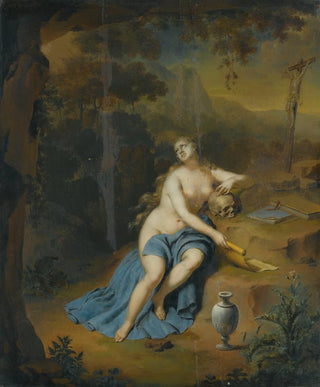Art print | Marie-Madeleine pénitente dans un paysage - Willem van Mieris


View from behind

Frame (optional)
The canvas "Marie-Madeleine pénitente dans un paysage" by Willem van Mieris is a captivating artwork that immerses the viewer in the complex universe of spirituality and redemption. This piece, emblematic of the 17th century, evokes not only the biblical figure of Mary Magdalene but also universal themes of self-discovery and repentance. The delicacy of the details and the richness of the colors invite deep contemplation, allowing one to grasp the full emotional depth conveyed by this representation. Through this work, Mieris succeeds in capturing a moment of introspection, where the protagonist appears both vulnerable and strong, lost in her thoughts yet in harmony with the surrounding nature.
Style and uniqueness of the work
Willem van Mieris's style is distinguished by an exceptional mastery of light and color, characteristic of the Baroque movement. In "Marie-Madeleine pénitente dans un paysage," the artist employs subtle lighting to highlight the delicate features of the protagonist while creating an atmosphere imbued with serenity. The shades of green and brown that compose the landscape serve as a backdrop to Marie-Madeleine's melancholy, while her clothing, a deep red, symbolizes both her passion and her repentance. The composition is carefully balanced, with each element arranged to direct the gaze toward the expressive face of the saint. This painting also stands out for its ability to fuse the sacred and the profane, a feature that makes the work even more intriguing. The harmony between the character and her environment reflects a profound understanding of human psychology, making this piece timeless.
The artist and his influence
Willem van Mieris, born in 1662 in Leiden, is a Dutch painter who established himself in the art world thanks to his exceptional talent and unique approach to painting. Trained by his father, also an artist, Mieris developed a style that combines technical finesse with emotional sensitivity. His works are often marked by meticulous attention to detail, which makes them particularly

Matte finish

View from behind

Frame (optional)
The canvas "Marie-Madeleine pénitente dans un paysage" by Willem van Mieris is a captivating artwork that immerses the viewer in the complex universe of spirituality and redemption. This piece, emblematic of the 17th century, evokes not only the biblical figure of Mary Magdalene but also universal themes of self-discovery and repentance. The delicacy of the details and the richness of the colors invite deep contemplation, allowing one to grasp the full emotional depth conveyed by this representation. Through this work, Mieris succeeds in capturing a moment of introspection, where the protagonist appears both vulnerable and strong, lost in her thoughts yet in harmony with the surrounding nature.
Style and uniqueness of the work
Willem van Mieris's style is distinguished by an exceptional mastery of light and color, characteristic of the Baroque movement. In "Marie-Madeleine pénitente dans un paysage," the artist employs subtle lighting to highlight the delicate features of the protagonist while creating an atmosphere imbued with serenity. The shades of green and brown that compose the landscape serve as a backdrop to Marie-Madeleine's melancholy, while her clothing, a deep red, symbolizes both her passion and her repentance. The composition is carefully balanced, with each element arranged to direct the gaze toward the expressive face of the saint. This painting also stands out for its ability to fuse the sacred and the profane, a feature that makes the work even more intriguing. The harmony between the character and her environment reflects a profound understanding of human psychology, making this piece timeless.
The artist and his influence
Willem van Mieris, born in 1662 in Leiden, is a Dutch painter who established himself in the art world thanks to his exceptional talent and unique approach to painting. Trained by his father, also an artist, Mieris developed a style that combines technical finesse with emotional sensitivity. His works are often marked by meticulous attention to detail, which makes them particularly






